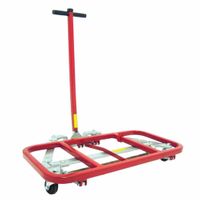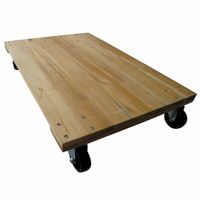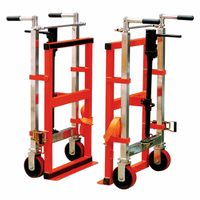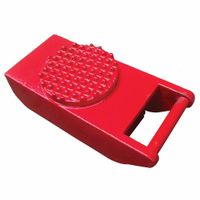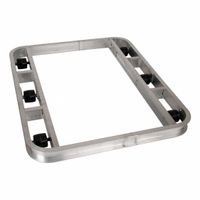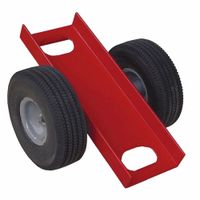Call +(254) 703 030 000 / 751 483 999 / 721 704 777
- Home
- Material Handling
- Transporting
- Dollies Movers
.....Read More
Frequently Asked Questions
What is the difference between a dolly and a hand truck?
A dolly and a hand truck are both tools used for moving heavy items, but they differ in design and functionality.
A dolly, often referred to as a moving dolly or furniture dolly, is a flat platform with four wheels. It typically has a rectangular shape and is made of wood or metal. Dollies are designed to carry large, heavy, or bulky items like furniture, appliances, or stacked boxes. The flat surface allows for easy loading and unloading, and the four wheels provide stability and maneuverability. Dollies are ideal for moving items over short distances on flat surfaces.
A hand truck, also known as a two-wheeler, sack truck, or trolley, is an L-shaped tool with two wheels and a small ledge or platform at the bottom. It is designed to be tilted back, allowing the user to leverage the weight of the load. Hand trucks are commonly used for moving boxes, crates, and other items that can be stacked. They are particularly useful for navigating stairs and uneven surfaces due to their two-wheel design. Hand trucks often have handles for better control and may include straps or attachments for securing loads.
In summary, the main differences lie in their design and intended use: dollies have a flat platform with four wheels for stability and are suited for large, heavy items on flat surfaces, while hand trucks have an L-shaped design with two wheels for leverage and are better for stacked items and navigating stairs.
How much weight can a dolly typically support?
A dolly, commonly used for moving heavy objects, can typically support a weight range from 600 to 1,200 pounds. However, the exact weight capacity depends on the type and design of the dolly. Lightweight dollies, often used for smaller household items, may support around 600 to 800 pounds. Heavy-duty dollies, designed for industrial or commercial use, can handle weights up to 1,200 pounds or more. Specialized dollies, such as appliance dollies or furniture dollies, may have different capacities based on their intended use. Always check the manufacturer's specifications for the exact weight limit of a specific dolly model.
What types of dollies are best for moving furniture?
The best types of dollies for moving furniture include:
1. **Furniture Dolly**: This is a flat, square platform with four wheels, typically made of wood or steel. It is ideal for moving large, heavy items like couches, dressers, and appliances. Its low profile allows for easy loading and unloading.
2. **Appliance Dolly**: Also known as a hand truck, this dolly is designed specifically for moving heavy appliances. It features a tall frame with straps to secure the load and stair climbers to navigate steps. The wheels are often larger and more robust to handle heavy weights.
3. **Utility Dolly**: This is a versatile option that can be used for various types of furniture. It has a smaller platform than a furniture dolly and is equipped with two wheels and a handle for easy maneuverability. It is suitable for medium-sized items.
4. **Piano Dolly**: Specifically designed for moving pianos, this dolly has a wide base and heavy-duty wheels to support the weight and size of a piano. It often includes padding to protect the instrument during transport.
5. **Convertible Dolly**: This type can switch between a two-wheel hand truck and a four-wheel cart, offering flexibility for different moving needs. It is useful for both small and large furniture items.
6. **Carpeted Dolly**: Similar to a furniture dolly but with a carpeted surface, this dolly provides extra protection for delicate furniture finishes and is ideal for items that are prone to scratches.
Choosing the right dolly depends on the specific furniture being moved, the weight capacity required, and the terrain over which the furniture will be transported.
How do you properly load and secure items on a dolly?
To properly load and secure items on a dolly, follow these steps:
1. **Choose the Right Dolly**: Select a dolly that suits the size and weight of the items. Use a utility dolly for boxes and a furniture dolly for larger items.
2. **Inspect the Dolly**: Ensure the dolly is in good condition, with no damage to the wheels or platform.
3. **Prepare the Items**: Securely pack items in boxes, ensuring they are sealed and labeled. For furniture, remove any detachable parts.
4. **Position the Dolly**: Place the dolly on a flat, stable surface. Ensure the wheels are locked if the dolly has brakes.
5. **Load Heavy Items First**: Place the heaviest items at the bottom to maintain a low center of gravity. This prevents tipping.
6. **Stack Items Securely**: Stack boxes or items evenly, ensuring they are balanced. Avoid stacking too high to prevent toppling.
7. **Use Straps or Bungee Cords**: Secure the load with straps or bungee cords. Wrap them around the items and the dolly frame to prevent shifting during movement.
8. **Check Stability**: Gently shake the dolly to ensure the load is stable and secure. Adjust straps if necessary.
9. **Push, Don’t Pull**: When moving the dolly, push it forward rather than pulling. This provides better control and reduces the risk of injury.
10. **Navigate Carefully**: Move slowly, especially around corners and on inclines. Keep an eye on the path to avoid obstacles.
11. **Unload Safely**: Once at the destination, carefully remove the straps and unload items, starting from the top.
By following these steps, you ensure the safe and efficient transport of items using a dolly.
Are there specific dollies for moving appliances?
Yes, there are specific dollies designed for moving appliances. These appliance dollies are specialized tools that make the transportation of heavy and bulky items like refrigerators, washing machines, and ovens more manageable and safer. They typically feature a sturdy frame, often made of steel, to support the weight of large appliances.
Key features of appliance dollies include:
1. **Straps and Belts**: Many appliance dollies come equipped with straps or belts to secure the appliance in place, preventing it from shifting or falling during transport.
2. **Stair Climbing Capability**: Some models are designed with stair climbers, which are additional wheels or tracks that make it easier to move appliances up and down stairs.
3. **Wheels**: Heavy-duty wheels, often made of rubber, provide smooth movement and reduce the risk of damaging floors. Swivel wheels may be included for better maneuverability.
4. **Height and Width Adjustability**: Some dollies offer adjustable height and width to accommodate different sizes of appliances, ensuring a snug fit.
5. **Ergonomic Handles**: Handles are often designed for comfort and control, allowing the user to maintain a firm grip while moving heavy items.
6. **Load Capacity**: Appliance dollies are built to handle significant weight, often supporting loads of several hundred pounds.
These features make appliance dollies an essential tool for both professional movers and homeowners who need to relocate large appliances. They help reduce the physical strain on the user and minimize the risk of injury or damage to the appliance and property.
What safety precautions should be taken when using a dolly?
When using a dolly, several safety precautions should be observed to prevent accidents and injuries:
1. **Inspect the Dolly**: Before use, check for any damage or defects, such as broken wheels or handles. Ensure all parts are functioning properly.
2. **Load Securely**: Ensure the load is balanced and securely fastened to prevent shifting or falling. Use straps or ropes if necessary.
3. **Weight Limit**: Do not exceed the dolly's weight capacity. Overloading can lead to equipment failure and accidents.
4. **Proper Lifting Techniques**: Use your legs, not your back, to lift the load onto the dolly. Bend your knees and keep your back straight.
5. **Clear Pathway**: Ensure the path is clear of obstacles, debris, or uneven surfaces that could cause the dolly to tip or become stuck.
6. **Use Ramps for Stairs**: Avoid using a dolly on stairs unless a ramp is available. If necessary, use a stair-climbing dolly designed for such purposes.
7. **Push, Don’t Pull**: Always push the dolly instead of pulling it. This provides better control and reduces the risk of back strain.
8. **Wear Appropriate Gear**: Use gloves to protect your hands and wear sturdy footwear to prevent foot injuries.
9. **Two-Person Operation**: For heavy or awkward loads, have a second person assist to ensure stability and control.
10. **Slow and Steady**: Move at a controlled pace to maintain balance and control over the dolly.
11. **Use Brakes**: If the dolly is equipped with brakes, engage them when loading or unloading to prevent movement.
12. **Training**: Ensure all users are trained in proper dolly handling techniques and understand the safety protocols.
By adhering to these precautions, the risk of accidents and injuries can be significantly minimized when using a dolly.
Can dollies be used on stairs or uneven surfaces?
Dollies are generally not designed for use on stairs or uneven surfaces. They are typically equipped with small wheels that are best suited for flat, smooth surfaces. Using a dolly on stairs can be dangerous as it may lead to loss of control, causing injury or damage to the items being transported. Similarly, uneven surfaces can cause the dolly to tip over or become stuck, making it difficult to maneuver.
However, there are specialized stair-climbing dollies available that are designed to navigate stairs. These dollies often have a tri-wheel or track system that allows them to move up and down stairs more safely. They are specifically engineered to distribute weight evenly and provide stability on steps.
For uneven surfaces, some dollies come with larger, pneumatic wheels that can handle rougher terrain. These wheels provide better shock absorption and traction, making it easier to move across gravel, grass, or other uneven surfaces.
In summary, while standard dollies are not suitable for stairs or uneven surfaces, specialized versions exist for these purposes. Always ensure you are using the right type of dolly for the task to ensure safety and efficiency.

